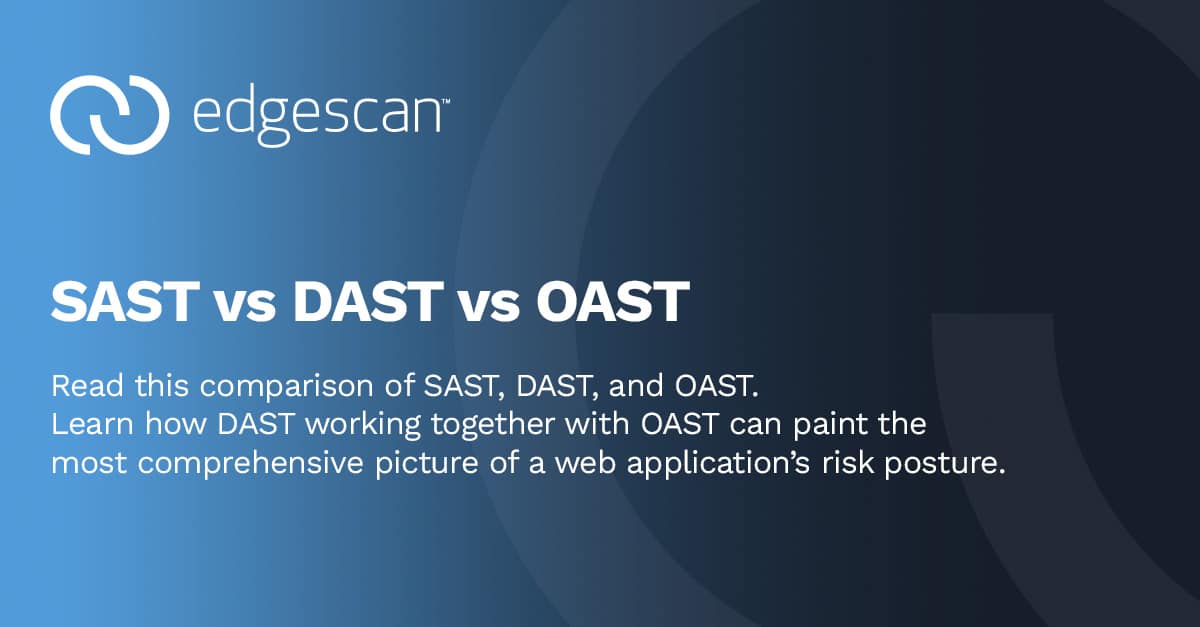The two most prominent approaches to application security testing are Static Application Security Testing (SAST) and Dynamic Application Security Testing (DAST). While both play critical roles in identifying vulnerabilities, there’s a growing consensus in the cybersecurity community about the benefits of DAST when combined with Out-of-Band Application Security Testing (OAST). This article compares SAST, DAST, and OAST, while describing how DAST working together with OAST can paint the most comprehensive picture of a web application’s risk posture.
SAST
Static Application Security Testing (SAST) examines source code at a fixed point in time. It is a “white-box” testing method that analyzes an application from the inside out, checking the codebase for security flaws without executing the code.
Benefits of SAST:
- Early Detection: Identifies vulnerabilities early in the development cycle.
- Comprehensive Code Coverage: Scans the entire codebase, including areas that might be missed during manual review.
- Language Specific: Customized to understand specific programming languages deeply.
Limitations of SAST:
- False Positives: The level of detail from SAST scanners generally leads to noisy results, generating false positives that require manual validation to prove they aren’t real vulnerabilities. This takes away time that could be spent on business or internal IT projects. If not, false positive results can be noisy and annoy developers!
- False Negatives/Limited runtime Analysis: Cannot identify issues that only appear during an application’s execution.
- Legacy technology: May struggle to keep pace with the latest frameworks and languages, due to the specificity of SAST scanners.
DAST
Dynamic Application Security Testing (DAST) is a “black-box” technique that tests an application from the outside during runtime. It is designed to simulate the POV of a hacker trying to exploit vulnerabilities in web applications. DAST can be deployed in production or pre-production environments.
Benefits of DAST:
- Real-world Attack Simulation: Detects external attack surface vulnerabilities that only appear when the application is running.
- Language Agnostic: Works independently of the programming language, making it versatile for large enterprises with thousands of web applications.
- Identification of Runtime Issues: Catches problems related to authentication, session management, and more.
- Accurate results: DAST produces results with high accuracy and with very few false positives
Limitations of DAST:
- False positives/negatives: DAST is not ideal for discovering blind vulnerabilities or asynchronous bugs, but these weaknesses can be shored up by employing OAST. – “Good” DAST should generally require validation to reduce noise again.
- Limited Code Visibility: Cannot pinpoint the exact location in the code where the vulnerability exists.
OAST
Out-of-band Application Security Testing (OAST) detects vulnerabilities that are not observable in standard responses from the tested application. OAST works by sending an attack payload that causes an interaction with a monitored external system sitting outside the target domain. The response received by an external system to the initial attack payload determines whether a vulnerability was discovered. DAST provides a realistic snapshot of an application’s security posture in production, but its capabilities are significantly enhanced when combined with OAST.
Benefits of OAST:
- Detection of Hidden Vulnerabilities: Ideal for identifying complex security issues, such as blind SQL injection, Server-side request forgery (SSRF) or OS Code Injection.
- Zero Day Coverage: SAST and DAST scanners typically rely on vulnerability signatures or patterns. OAST utilizes vulnerability signatures but also detects unusual responses that might indicate the presence of a zero-day vulnerability.
- The infamous Log4Shell vulnerability was discovered by capturing a DNS A request using out-of-band techniques.
- Identify Attack Surface: OAST can identify vulnerabilities in complex applications that include distributed architectures and microservices. It can even test APIs, whose vulnerabilities are becoming an increasingly popular attack vector.
Conclusion
SAST is ideal for early codebase analysis, while DAST excels in simulating real-world attack scenarios. SAST is a necessary tool for debugging before deploying a web application, but it doesn’t offer continuous coverage of your production environment or the ability to detect Runtime issues. Combining DAST with OAST offers a more comprehensive and actionable approach to security testing once an application has been deployed. OAST is particularly effective in detecting and addressing complex vulnerabilities like blind vulnerabilities, which might otherwise go unnoticed by traditional application security testing methods. DAST provides highly accurate results, where you can be sure the vulnerabilities being discovered are real. As cybersecurity threats grow more sophisticated, the integration of DAST with OAST represents a proactive trend in application security, ensuring more secure and resilient applications in an increasingly digital world.








